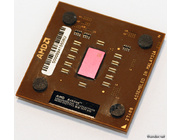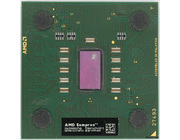A lot like this Athlon XP 2500+ but about a year older. I picked up this CPU cheap and because it's a year older it has two differences:
1. Different PCB substrate. The older versions have a smooth surface (with modifiable traces).
2. It has been made in the 6th week of 2003. I've had a couple of Athlon XP's from that time-period that overclocked very well (not to imply that newer ones don't- some of them clock very well too) so I want to test if this one is very capable too. > Read more
Built for notebooks with a different socket compared to the desktop versions of the Athlon XP. Some Athlon XP-M's did use the regular S462 socket, however. The 462-socket Athlon XP-M's used to be popular with overclockers because the chips used on the 130nm XP-M's usually overclock very high.
The Athlon XP-M never obtained a broad market in Europe. Most notebooks were equipped with the Pentium M which had better performance and consumed less power. Also many notebook-designers often had better cooling designs and notebooks with more options and varieties for the Intel parts which favoured sales for the Pentium M as well. > Read more
Just like this Athlon XP-M 2000+ but 100+/66MHz slower. > Read more
Launched 10th of February, 2003. The Athlon 64 (based on the Hammer core) was delayed so AMD had to rely on the Barton core which made it's way onto the Athlon XP 3000+.
Barton is basically just a Thoroughbred core but has 256KB more L2-cache. The first Barton CPU's launched were the 2800+ and 3000+ and they all used the 166MHz (DDR333) FSB. > Read more
AMD's fastest production Athlon XP! In May 2003 this CPU was released with a 200MHz (DDR400) FSB and a clockfrequency of 2200MHz. A few months later, in October, AMD also released a 166MHz (DDR333) / 2333MHz model.
The 3200+ performed not bad but it isn't as spectacular as the older situation with the Athlon XP 1800+ and the Pentium 4 1800MHz for example. The Pentium 4 3GHz (200Mhz QDR800 FSB) got ahead on the 3200+. Perhaps it would've been better if the 3200+ was clocked at 2300MHz.
This 3200+ CPU is multiplier locked. A lot of 130nm Athlon XP's aren't. > Read more
A Sempron with a Barton core. It has an extra 256KB L2 cache (512KB in total) compared to the older Semprons with a Thoroughbred core. The Sempron was a budget processor and it's rating numbers aren't comparable with it's brother, the Athlon XP. For instance, the Athlon XP 3000+ with 166MHz (DDR333) FSB runs 166MHz faster. > Read more
Almost two years after the introduction of the 2800+ and the 3000+, AMD decided to ship out a 2900+ model. I never saw these CPU's much which is probably due the fact that the Athlon 64 was out for a few months. > Read more
Just like the 2500+ but one step faster.
The slower Athlon XP's that were made in the end of 2002 had an unlocked multiplier. This meant that overclockers could overclock/tweak more easily. This Barton CPU doesn't have an unlocked multiplier anymore because AMD didn't want people to sell a 3000+ (for example) that originally was a 2500+. The multiplier lock was introduced around week 40 of 2003.
Despite the multiplier lock people could still overclock the CPU's by raising the FSB. In case of the 2500+ it was often possible to raise the FSB to 200MHz (DDR400) instead of the original 166MHz (DDR333) which would give you an Athlon XP 3200+. > Read more
The 2500+ was the slowest Barton CPU when the new Barton cores were released. Barton is technically a Thoroughbred B core with 512KB L2-cache in total.
Because of the extra L2-cache AMD gave the Barton CPU's a higher rating. The Athlon XP 2600+ with 256KB L2 and 166MHz (DDR333) FSB runs at 2083MHz and the Barton model with 512KB L2 runs at 1917MHz. That's a difference of 166MHz and I don't think the extra L2-cache can compensate for that 166MHz. In some cases the bigger L2-cache doesn't even show any performance jumps compared to 256KB L2 ![]() . In my opinion the Barton 2500+ should've had a clock frequency of 1917MHz and the Barton 2600+ 1983MHz
. In my opinion the Barton 2500+ should've had a clock frequency of 1917MHz and the Barton 2600+ 1983MHz ![]() . > Read more
. > Read more















